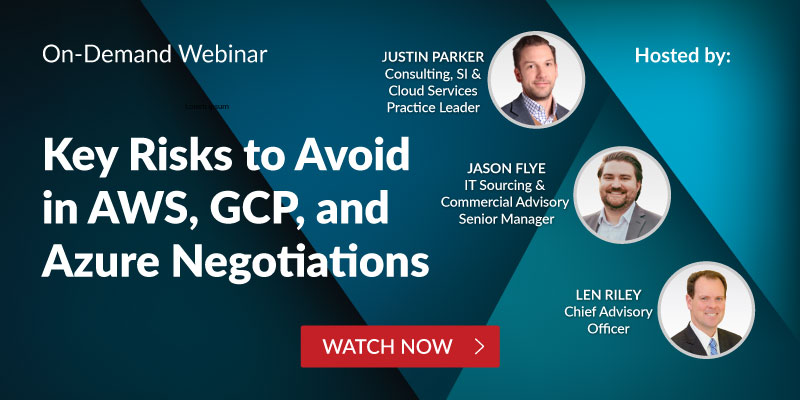- Len Riley
- Reading Time: 6 minutes

The rise of business transformation initiatives has IT leaders rethinking the way they evaluate, select, and negotiate technology and IT services deals today. Pivoting away from a serial approach to evaluation and selection, forward-thinking IT leaders are instead employing an integrated sourcing strategy tailored to facilitate business and IT transformations.
Several dynamics are fueling this trend. On the buy side, business executives are looking to transform their ERP, SCM, CRM, HR, and ecommerce platforms to address inadequacies exposed by the COVID pandemic, global supply chain issues, changes in workforce dynamics, and industry-specific opportunities and challenges. At the same time, CIOs are working to reshape the business of IT, driving their organizations to the cloud and to new delivery and operating models.
On the sell side, vendors have revamped their go-to-market strategies, service offerings, and partnerships. SAP, for example, has launched its RISE offering, including reimagined partnerships with AWS, Google, and Microsoft as well as its consulting partners such as Accenture and IBM to bring a vertically integrated solution to market. Meanwhile, AWS, GCP, and Microsoft are partnering with consultants to present holistic cloud migration and application modernization strategies beyond SAP.
Organizations undertaking business transformations involving SAP in particular are faced with a range of intertwined issues around vendor engagement, evaluation, selection, and negotiation, the interdependencies of which must be understood in order to drive sound decision-making and beneficial outcomes.
Following are eight strategic concerns and imperatives for establishing and executing an SAP transformation primed for success.
1. Choosing SAP S/4HANA RISE vs. perpetual license model
As organizations map their journey from SAP ECC to S/4HANA, they must determine whether SAP RISE or an SAP S/4HANA perpetual license model is the best fit. Key to this decision is understanding the implications of moving from a capital-intensive purchase model to an operating expense model.
Organizations must also assess whether SAP RISE will deliver on their operational requirements. Many organizations may be reluctant to turn control over to SAP due to prior experiences with SAP HEC, or they may struggle to understand the true scope and services included as part of RISE. Organizations considering SAP RISE must also come to terms with putting a significant amount of their AWS, GCP, or Microsoft Azure spend behind their SAP relationship, versus maintaining a direct relationship with their hyperscaler of choice. Lastly, organizations must also carefully assess the SAP RISE cost and commercial model against the SAP S/4HANA perpetual license model and commercial terms.
2. Establishing an SAP partner strategy
In addition to selecting the SAP platform, organizations must also determine their consulting and implementation partner strategy. Here, several decisions are key, including whether to undertake a Phase 0 initiative to determine objectives and scope, as well as whether this phase should be awarded as a sole source event or as part of a competitive bid process.
Subsequent to Phase 0, organizations must determine early whether they will seek partners for the design, build, and deploy phases of the program. Organizations will be challenged with building a plan that drives the timeline necessary to achieve business objectives while employing a sourcing strategy that maximizes insights that can be obtained from the market via a competitive bid process. This is critical in today’s market given current levels of attrition, inflation, and demand for high-end consulting resources. A final consideration is devising a strategy with respect to the evaluation, selection, and award of any non-SAP cloud migration and application modernization support.
3. Re-examining hyperscaler partnerships
Organizations must also re-evaluate their cloud strategy. In addition to determining their long-term infrastructure support strategy for SAP, organizations are also likely to be moving SAP workloads to the cloud, retiring certain applications, or determining which applications should remain on premises or in a hosted environment. This would entail an evaluation of AWS, GCP, and Microsoft, as well as the possible undertaking of a multicloud strategy, a preferred/challenger vendor model, and an approach to addressing the short- and long-term requirements of these relationships.
For example, many organizations that are in the process of making commitments to Microsoft Azure, or exceeding the commitments previously made, need to determine whether they’re going to open up the entire Microsoft relationship to renegotiation. In addition, organizations need to evaluate the role of the hyperscaler in supporting the migration effort as well as the associated investments they are willing to make to support not only the SAP migration but the non-SAP migration. Millions of dollars are on the table to be captured or potentially wasted if orchestration of the hyperscaler evaluation, selection, and negotiation is not well coordinated with the corresponding workstreams.
4. Defining a future managed service strategy
Organizations must also determine not only their managed services strategy but also whether the vendors that are part of this strategy will participate in supporting their future-state SAP environment. Typically, this would include deciding whether the SAP systems implementation provider will provide application maintenance and support (AMS) for the future-state environment versus using an incumbent AMS provider to provide support for the existing environment and future-state environment.
Organizations will also need to understand what complementary infrastructure management services are required to support an SAP RISE environment or an SAP on-premises environment, as they certainly differ. It is essential that an organization’s future managed service partner strategy be considered in concert with determining whether to commit to SAP RISE or a perpetual license.
5. Reassessing existing managed service relationships
In many cases, an organization’s future managed service strategy will require revisiting relationships with existing managed service providers. Such a realignment could necessitate the removal or addition of service towers, removal or addition of workloads, modification of governance and operating models, or renegotiation of service levels, pricing, commercial terms, and conditions. As organizations look to the future, it’s critical that they understand the impact the future strategy will have on existing relationships while maintaining operational continuity during the transformation.
6. Aligning vision and strategy
A key dependency to developing an integrated sourcing strategy is to have a foundational view of the vision and overall strategy of the business and IT transformation initiatives. Unfortunately, in many cases, one aspect of the transformation vision and strategy maybe more advanced than another. For example, organizations highly focused on a business transformation may have engaged a consulting provider to conduct a phase 0 that would enable an S/4HANA implementation. The natural focus of this initiative would include development of the scope in the business case associated with the implementation, but often this means the run side of the vision is given short shrift, placing the organization in catchup mode trying to close the space between the vision for the business transformation and the vision for the IT transformation during the sourcing process, which is certainly not ideal.
Organizations that establish a view of their business and IT transformation in a holistic fashion are best positioned to develop a sourcing strategy to support that vision. In addition, organizations that establish their governing principles and objectives are best positioned to empower their team with a framework for decision making.
7. Building an effective team
Execution of an integrated sourcing strategy is highly dependent on the development of an effective team to support the transformation. The team must comprise a highly capable, collaborative set of individuals representing executive leadership, lines of business, IT, procurement, finance, and legal. This may seem facile advice, but the reality is there are material organizational challenges associated with aligning capable individuals across these different domains.
For example, most procurement organizations are aligned by category of spend such as software and services and they do not have an individual capable of executing across all workstreams except at the highest levels of the organization. In addition, major disconnects can exist between line of business executives, a designated transformation executive, and their IT counterparts with respect to strategy and approach. Even within IT, disconnects between the application team and the infrastructure team can derail a process. These realities must be recognized at the outset of the program as leadership strives to develop a team with large-scale transformational experience that will have the complete support of executive leadership from day one.
Moreover, this team must be empowered to drive the project and the associated vendor evaluation selection and negotiation processes. Their level of credibility must be impervious to the top-down divide-and-conquer tactics and strategies that will be employed by consulting and technology providers and the scrutiny of executive leadership.
8. Establishing an integrated plan
Too often, there is a disconnect between the expectations of executive leadership, the project team, and the procurement team relative to the overarching timeline and approach to the program. It is essential that the sourcing strategy include a plan that integrates the vendor evaluation, selection, and negotiation process into the project plan. This plan must consider the key milestones and decision points for the entire program, including timing for business case finalization and presentation, timeframes for selection, and program commencement. This plan must also include a well-thought-out approach not only to the timing but the sequencing of the above workstreams in a manner that will enable good decision-making.
For example, presentation and analysis of SAP’s RISE proposal and perpetual license proposal must be coordinated in a manner that coincides with the presentation and evaluation of the hyperscaler proposals and total cost of ownership comparisons. Another example is determining whether the implementation provider is going to have an opportunity to provide associate application means and support. If so, your organization should be leveraging the full opportunity associated with both bodies of work to maximize results. Without this plan, internal misalignment can occur and your organization will be subject to vendors presenting their capabilities and commercial proposals at a time and place of their choosing.
The bottom line is that many organizations are caught flat-footed by implementing a serial approach to selecting technology platforms, consulting and implementation providers, and managed service providers. The reality is the service offerings of technology providers and service providers alike address all three aspects of the technology lifecycle and they must be evaluated in a well-orchestrated and parallel path manner. Organizations that create and execute on an integrated sourcing strategy will be well positioned to make good decisions that set their program up for success, while maximizing their leverage to drive the best-in-class commercial agreements with all providers.
Our SAP Practice Advisors are experts in S/4HANA migrations and can help you build an integrated sourcing strategy informed by a holistic view of your business and the evolving market. We focus on helping our clients form a strategic relationship with SAP to achieve significant savings and long-term value. If you have a transformation program to negotiate, reach out to an SAP advisor today!
Reprinted with permission. © IDG Communications, Inc., 2022. All rights reserved.

